
37 minute read
Nutrition - including the
The Benefits of BALANCERS
Balancers are often misunderstood but really are an excellent feeding option for many horses.
Advertisement
What They Are Balancers provide all the essential nutrients you’d find in a mix or cube, without the energy/calorie element so are fed in much smaller quantities. They are formulated to supply the nutrients known to be lacking in forage and pasture, which is even more important if hay is being soaked, which washes out nutrients as well as calories, or if grazing is stressed. Every balancer supplies a wide range of vitamins and minerals in carefully calculated ratios to meet a horse’s daily needs, including nutrients to support healthy hoof growth, metabolism, tissue repair etc. Unlike vitamin and mineral supplements, balancers also contain protein which supplies essential amino acids. These are the building blocks of all body tissues, including hoof, hair, muscle and bone, so are pretty important and also often deficient in modern forages. Most balancers also contain ‘digestive enhancers’, like yeast culture or prebiotic, which support gut efficiency. Some balancers are said to contain special ‘supplements’ to target certain issues but this is just another way of saying they contain all the nutrients necessary to support these areas. Great for Good-Doers Because balancers are concentrated and fed in such small quantities, their calorie contribution to a horse’s overall diet is negligible, making them perfect for horses who maintain condition on forage alone or those on calorie-controlled diets. They’re low in starch and sugar, so suitable for those prone to laminitis, and will help build and maintain muscle tone in working good-doers, whose requirements for essential nutrients can be met without adding to their waistlines. Feeding a low calorie balancer, alongside forage, is better than feeding a ‘token gesture’ of a mix or cube or no hard feed or supplement at all, as it ensures the horse receives a fully balanced diet, without going to the waistline. Many a ‘lazy’ good-doer, fed no or little hard feed, feels happier and healthier when receiving a fully balanced diet through the recommended amount of a balancer. They often start to find work easier and, as fitness levels improve, so can achieve a healthier body condition. Added Flexibility Horses’ calorie requirements can fluctuate with workload and depending on the contribution made by grass and forage. Spring and summer grazing may supply plenty of calories so feeding the full recommended amount of a mix or cube, that may be appropriate through the winter, would provide too many additional calories and has to be cut back. While this controls calories, it also reduces intake of essential nutrients so adding balancer to reduced amounts of hard feed, brings nutrient levels back up without unwanted calories, and helps ensure the horse continues to receive a fully
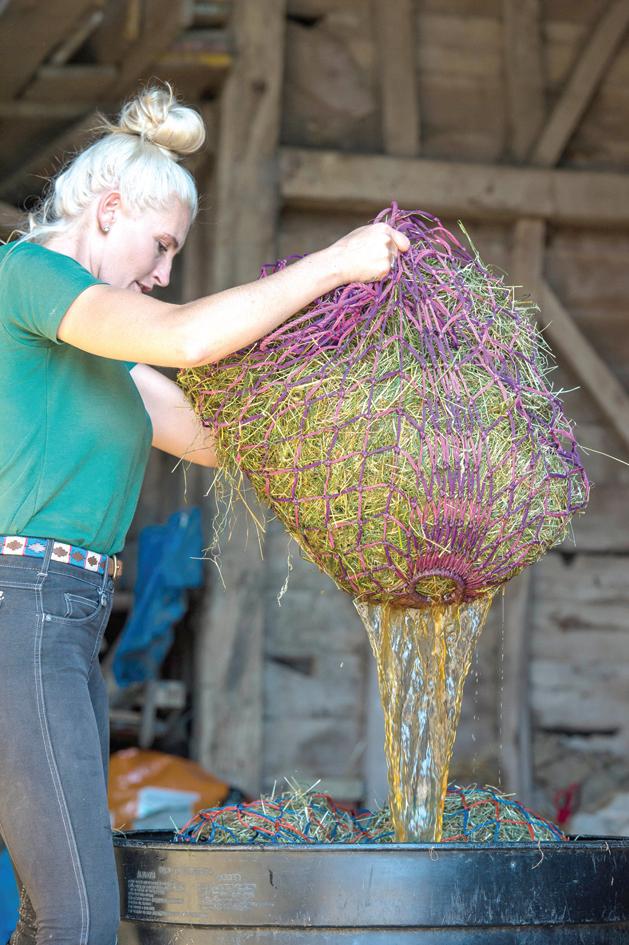
Continued overleaf...

Continued from previous page...
balanced diet. This is important to support health, wellbeing and performance as well as healthy hoof growth and recovery. Great for Sharp Horses All balancers are low in starch, sugar and energy so will not exacerbate excitability or fizzy behaviour. Any dietary changes should always be made gradually, to allow a horse’s digestive system and hind gut bacteria to adapt but, for those horses who tend to be sharp or stressy, it’s always a good idea to make these changes more slowly. This is even more important if the previous diet was lacking or imbalanced and you are introducing a new feed or balancer to rectify this. Great for ‘Condition’ Good condition is as much about muscle tone, top line, hoof quality and coat shine as it is about levels of body fat so feeding a balancer, at recommended levels, should help to improve all these aspects of a horse’s condition. The pre and probiotic content helps improve digestive efficiency so even those on a forageonly diet should be able to ‘make more’ of the diet overall. In some, this may even result in a little weight gain but even those balancers described as ‘conditioning’ will not provide sufficient calories for horses who need significant weight gain. They will need to increase their calorie intake and the most efficient way to do this is with a specially formulated highly digestible, calorie-dense conditioning feed.
www.baileyshorsefeeds.co.uk
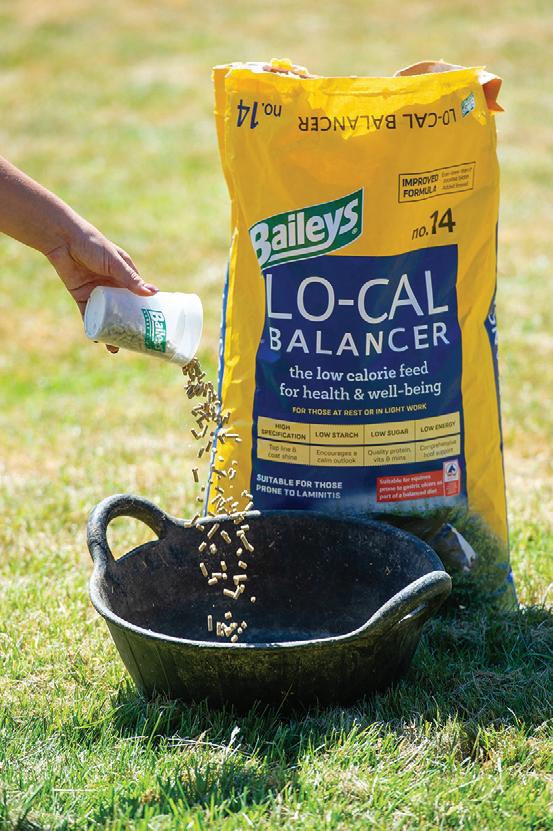
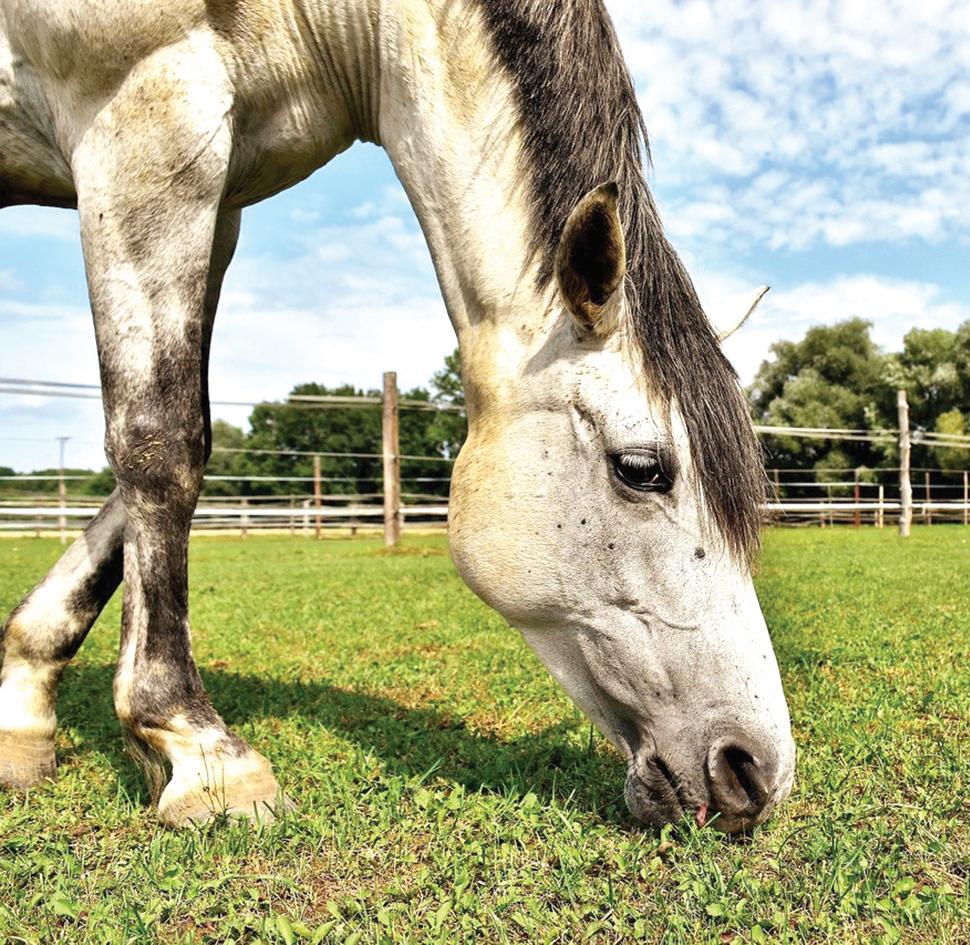
BALANCERS ARE THE BEST OPTION
FOR WEIGHT WORRIES
Spillers have been running an informative online campaign recently, Nutrients Not Calories, to help horse owners learn about the unique benefits of balancers, to us help keep our horses healthy and slim, and Newmarket vet Lucy Grieve has applauded the initiative.
Balancers are worth their weight in gold when your horse needs to cut back on calories but not nutrients, and used in addition to appropriate management they can help you to reduce the risks of obesity and its associated conditions such as laminitis. Nutritionists at Spillers will be publishing a series of blogs, videos and infographics to explain what balancers are, the power of feeding by the cupful rather than by the scoop and the daily nutrients horses need beyond those supplied by forage alone. The campaign has the support of Lucy Grieve, a frontline vet at Rossdales Veterinary Surgeons, Newmarket. “A significant proportion of the UK equine population (up to 70%) are overweight and so actually require a weight loss diet which excludes compound feeds altogether,” said Lucy. “In these cases, a ‘balancer’ is appropriate and allows the horse to receive what it needs without receiving the excessive calories that are going to do it more harm than good. “I think compound feeds are
probably used too much by too many, where a balancer is usually sufficient,” she continued. “Unfortunately, many horse owners think their horse is in harder work than it actually is, warranting increased rations but hard work would actually be an advanced eventer or racehorse in full work! I try to persuade all my nonprofessional clients to start with a balancer (together with forage) before even considering a compound feed. It’s amazing how many weight and behavioural issues are solved by this simple move!” Clare Barfoot RNutr, Marketing and Research and Development Director at Spillers, added: “A good balancer provides optimum levels of vitamins, macro and micro minerals and amino acids to balance the base diet, with minimal calories and starch. This makes them ideal for horses and ponies that keep their weight on a forage-only diet or those needing less than the recommended amount of compound feed.” Lucy Grieve concluded: “Every horse needs enough of the essential vitamins, minerals and quality protein to stay healthy but in my experience a lot of people still don’t really understand balancers and what lifesavers they are! We all love our horses and want to do our best for them and by opting for a balancer we can help to do just that.”
www.spillers-feeds.com
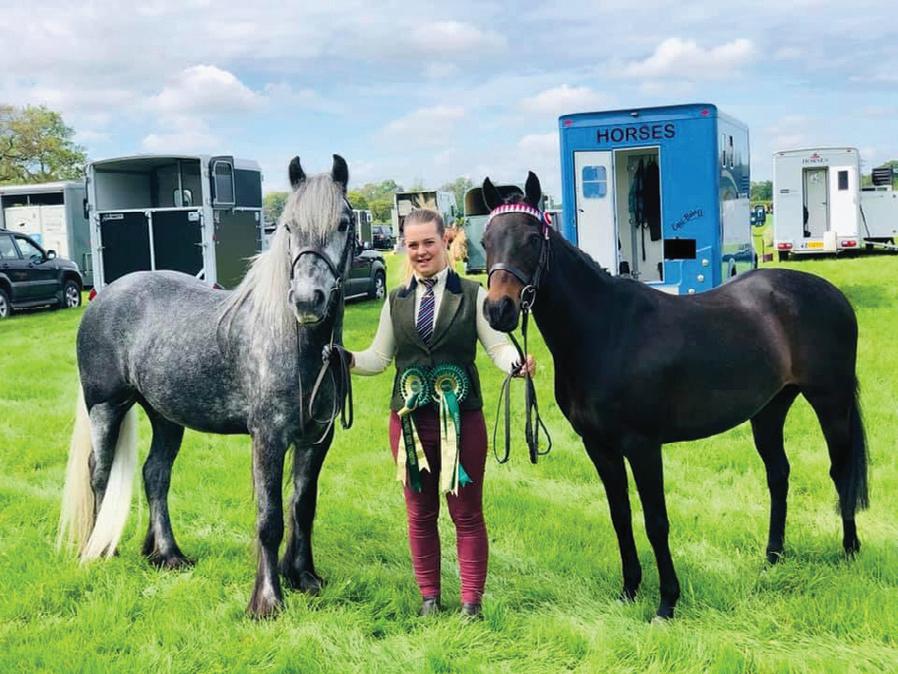
HEALTHY BODY CONDITION IN SHOW HORSES
Behaviour change scientist Dr Tamzin Furtado from Liverpool University has joined forces with The Horse Trust to reward healthy body condition in show horses and spread the word on how best to go about maintaining the healthiest weight.
Instigated by Tamzin and Jan Rogers at The Horse Trust, the programme targets both affiliated and unaffiliated shows up and down the country, providing friendly, supportive advice and guidance to owners, riders and producers, helping them to recognise the benefits of maintaining a healthy body condition. Both local and on-site vets work in conjunction with the Judges to score horses in the chosen classes and award a rosette to the healthiest body condition within the class. The pilot programme ran prior to the Covid-19 disruptions in 2019 and was very well received by competitors and professionals alike. David Ingle, Chairman of The Showing Council and Director of Showing at the Royal International Horse Show, Hickstead, said, “Showing is keen to become more educational and we are in an era of great improvement in equine welfare, with increasing scrutiny under social license. This initiative will help to shine a light on this important aspect of showing.” The Royal International Horse Show participated in the 2019 pilot programme and were pleased to include the initiative in their show schedule again at this year’s show. Other participants in the 2019 pilot included Bucks County Show, Great Yorkshire Show and Wheatley Horse Show. Tamzin Furtado says, “Horses who are overweight or cresty are often celebrated for their condition – and we want to slightly challenge that, by celebrating horses in ideal body condition.” Fellow Liverpool University graduate and vet, Ben Curnow, MRCVS, who judged body condition as part of the 2019 pilot programme, added, “It’s not about being critical of or challenging the judges, just showcasing what ideal body condition looks like.” The British Equine Veterinary Association considers equine obesity to be one of the highest-ranking equine health risks today. The Horse Trust is working with a number of horse world bodies to come up with practical solutions to enable human behaviour around equine obesity to be changed for the better. Jan Rogers says, “We get very upset by seeing photos of underweight horses in the media, but in reality, far more horses are obese than are underweight. This is very worrying for vets who are finding that they have to treat these horses with serious health conditions like Equine Metabolic Syndrome and Laminitis. Peoples’ perceptions of what is a healthy weight have shifted towards the higher body condition scores. We would like to help to reset this balance”.
Autumn can be a difficult time of year; the constantly changing weather and variations in temperature can make one day feel like summer and the next like winter.
There are several factors to take into consideration when it comes to autumn feeding. Each horse must be treated as an individual when developing a feeding regime at any time of the year so consider factors such as age, temperament, dentition, overall health and weight. Body condition scoring is a useful tool to monitor your horse’s condition throughout the year and always take note of the quantity of water your horse consumes. The darkening evenings often result in the horse’s work load being considerably reduced during the autumnal months. This regularly coincides with reduced turn out as horses are stabled during the night after free access to pasture during the summer months. A suitable balance will need to be reached to ensure the horse is receiving adequate levels of fibre and concentrates are not being overfed. 80 to 100% of the horse’s diet should be fibre-based and as we move through the autumn months a large proportion of this will be made up of forage. Fibre is important for many reasons but especially in helping the horse to maintain its body temperature. Heat is released when fibre, retained in the horse’s hindgut, is fermented by micro-organisms. This process of digestion is a very useful source of warmth for horses during the colder months, in particular those that live out. Sourcing good quality forage is obvious for many owners but this can become increasingly difficult as the winter months continue, so ensure your supplier has enough good quality forage to fulfil your horse’s autumn and winter requirements. The length of time we stable our horses often increases as we progress through the autumn so finding forage that is dust-free is vital for good respiratory health. Forage that comes with a quality guarantee can reduce costly wastage. We, as horse owners, often spend a considerable amount of time investigating the nutritional contents of our bucket feeds but we don’t always do the same for our forage. Choosing a forage that has been fully analysed will help in developing a balanced consistent diet for your horse or pony. HorseHage dust-free bagged forage comes in four varieties offering a choice for all types of horses and ponies including those prone to laminitis. It is consistent, contains no additives, comes with a 100% quality guarantee and has BETA NOPS certification. A broad spectrum vitamin and mineral source should be supplied in the horse’s diet throughout the year but it is particularly essential as the access to grazing becomes restricted.
www.horsehage.co.uk
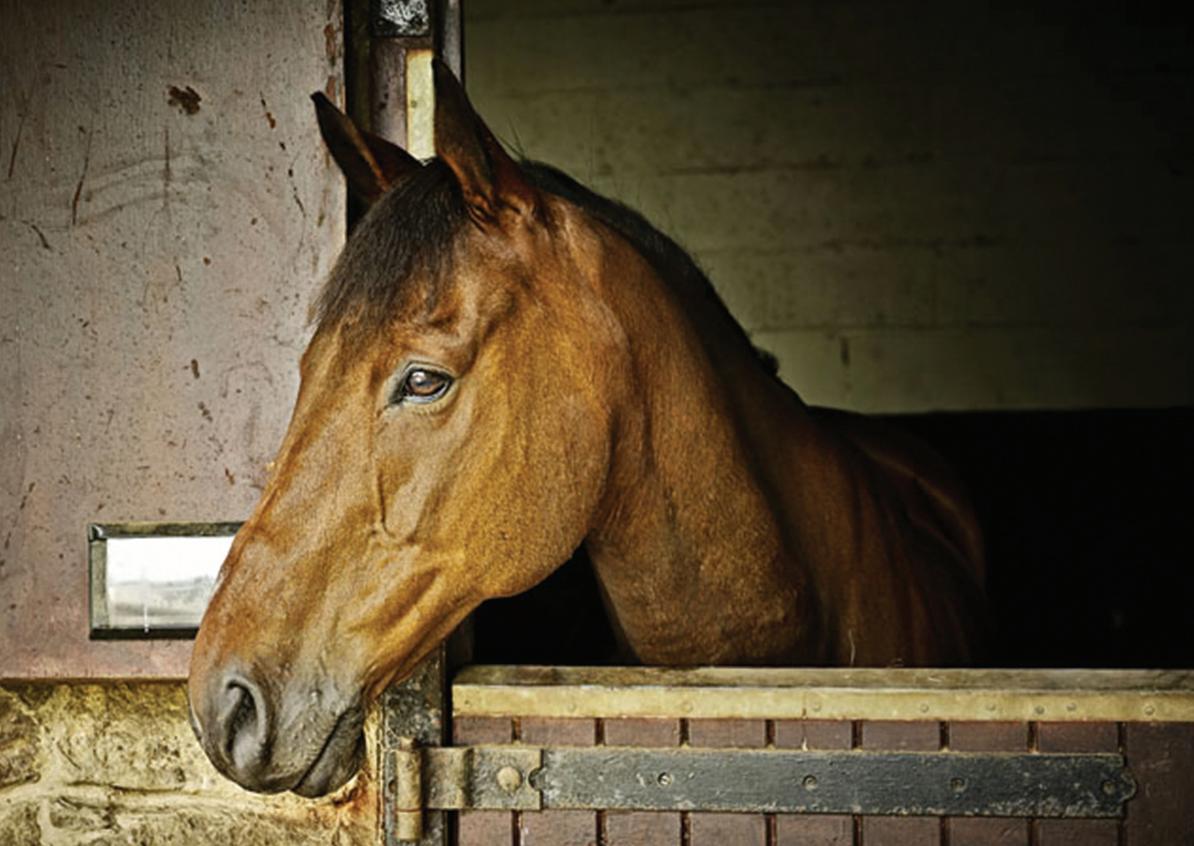
AUTUMN FEEDING
When grass grows under normal conditions, it contains high levels of soluble sugars and nonstructural carbohydrates (NSCs). When there is a ground frost and grass is frozen, the grass accumulates more sugars to try and enable it to carry on growing
in adverse conditions. This extra sugar content can be one of several different triggers for laminitis. If a horse or pony is prone to laminitis, it should be fed a low sugar, low starch and high fibre diet. It is important not to starve horses and ponies prone to laminitis as this can cause further problems. Choose forage that has a lower sugar content than hay, such as High Fibre or Timothy HorseHage and, ideally, a complete feed suitable for horses and ponies prone to laminitis that contains a broad spectrum vitamin and mineral supplement such as Mollichaff HoofKind Complete. Mollichaff HoofKind Complete is made from a balanced blend of high quality oat straw, dried alfalfa and fibre pellets and is topped with a light dressing of soya oil with added vitamins and minerals, trace elements, including magnesium and natural plant-based antioxidants, as well as added biotin.
www.horsehage.co.uk

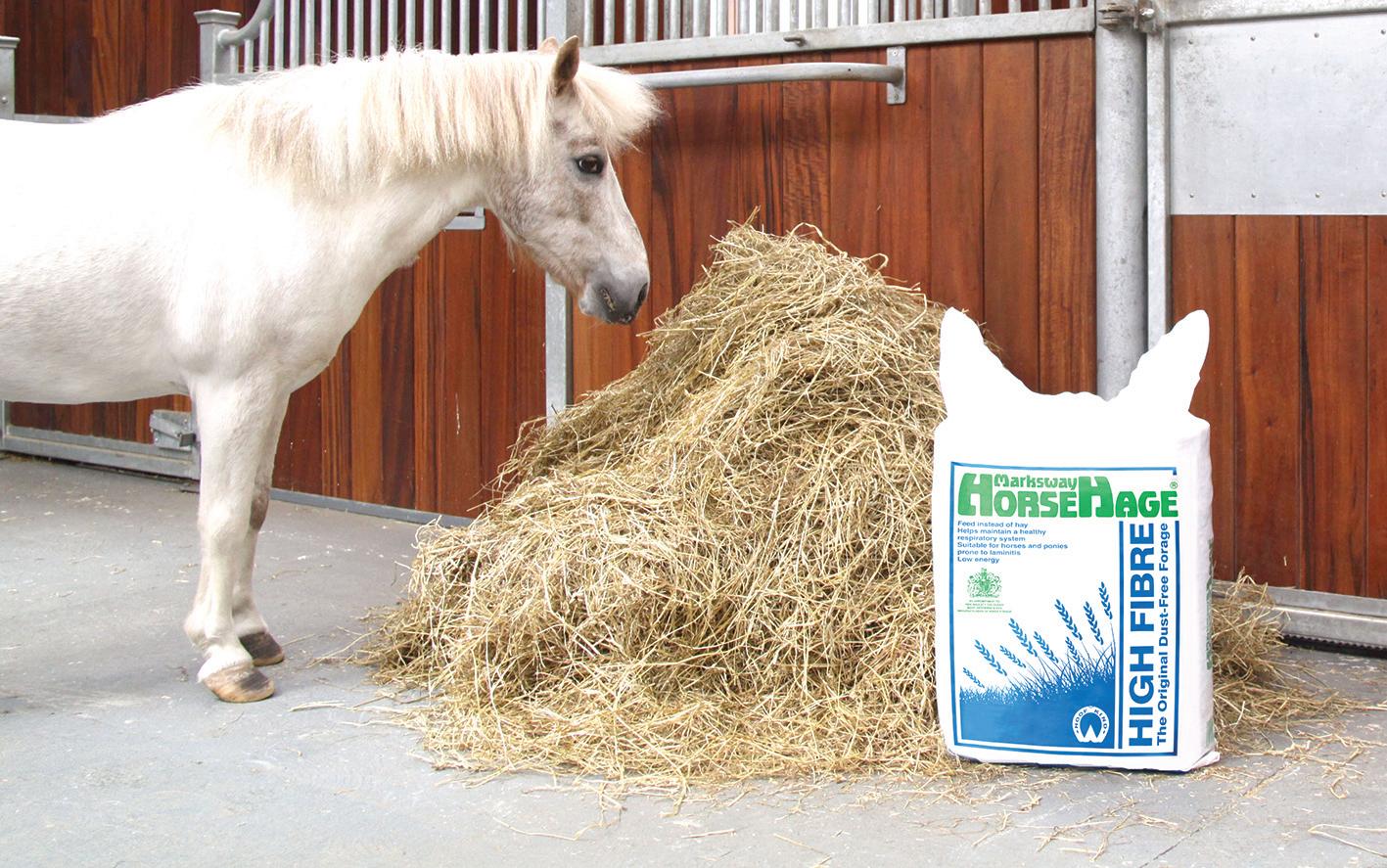
FEEDING FIBRE
FIVE FIBRE FACTS FROM HORSEHAGE AND MOLLICHAFF
In this issue we are talking all about fibre in your horse’s diet. This can be provided by the horse’s natural grazing, forage, chaff or high fibre feeds.
Here are five facts on the importance of fibre from HorseHage and Mollichaff:
1) Feed fibre first The horse, through evolutionary adaptation which has occurred over a period of 65 million years, has become a ‘trickle-feeder’. His digestive system, with its small stomach and very large bacteria-filled hind gut is designed to contend with an almost continuous supply of grass and herbage. Food is moved along the digestive tract by muscular contractions or fibre content of the natural herbage diet, releasing energygiving substances which the horse then uses. Contrary to some beliefs, fibre is not just a ‘filler’, as the hindgut micro-organisms create a delicate microbalance which, if upset, may result in health and performance problems and also may suppress the immune status of the horse, often creating a downward spiral of health problems. 3) Fibre can help buffer stomach acid Trickle feeding fibre such as chaff (a little at a time) encourages horses to chew, producing much more saliva than when concentrates are fed on their own and this alkaline saliva buffers the stomach acid. The presence of a high fibre feed such as chaff in the stomach helps to neutralise stomach acid. Chaff will also encourage chewing, prolonging feeding time and the production of increased amounts of acidbuffering saliva. Furthermore, alfalfa may actually have a more

waves known as peristalsis. The gut is designed to receive a small but regular and frequent supply of food (trickle feeding) to encourage these ‘waves’ to continue. A period of as little as eight hours without food may cause a slowing of these muscular contractions and impair the digestive process. A high fibre diet is a more natural way to feed you horse compared to a high cereal diet and forage can provide 70-100% of the diet. (If 100% of the diet is provided by forage, a broad spectrum vitamin or mineral source such as a good quality balancer should also be provided.) 2) Fibre – It’s not just a filler! Many horse owners feed a small amount of chaff just to bulk out the concentrate feed but there are other beneficial reasons for its use. Horses are predominantly fibre digesters or hindgut fermenters. Within the hindgut, are millions of microorganisms that play a vital role in breaking down the digestible

protective effect than other haybased chaffs because of the high protein and calcium content giving improved buffering properties. Feeding a bowl of alfalfa chaff or any chaff prior to exercise may be helpful as this will help to reduce the splashing effect of acid on an empty stomach.
4) Fibre can reduce boredom for stabled horses Feeding a chaff will stimulate the production of saliva and will satisfy a stabled horse’s psychological need to chew, as a product such as Mollichaff can require up to 8000 chews per kilo to eat compared to as few as 1200 for concentrates. By providing plenty of fibre to horses that have to spend increased periods of time stabled can prolong eating time and decrease the likelihood of stereotypical behaviour caused by stress and/or boredom. 5) Fibre – fuelling the horse’s central-heating system During cold weather, access to fibre has a double advantage as not only does it keep the digestive system functioning correctly, but additionally, the digestion of fibre in the hind gut creates heat as a by-product, quite literally warming your horse up from the inside out! The digestion of fibre in the horse’s system produces heat so it is also a vital tool to keep them warm, particularly if they live out or are not rugged.
www.horsehage.co.uk
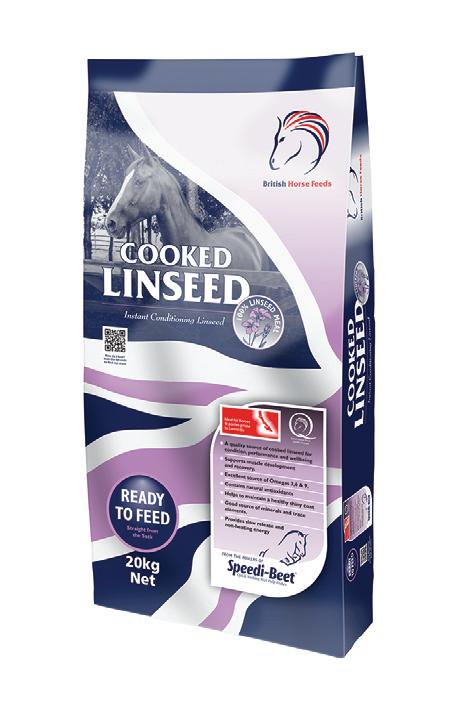
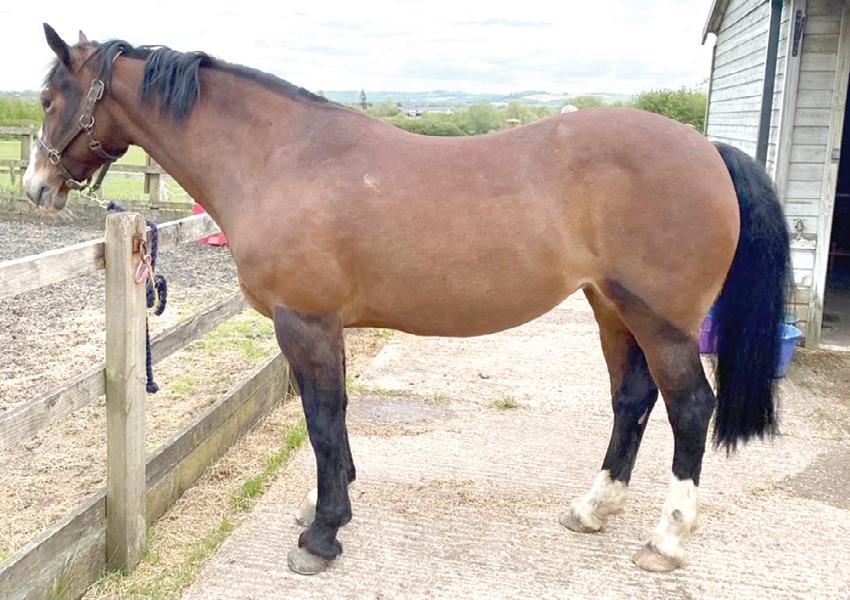
CAN YOU SPOT
AN OVERWEIGHT HORSE?
Spillers is helping horse owners ‘get their eye in’ on Body Condition Scoring (BCS) by running an online test to see who can spot an overweight horse or pony.
Obesity is a major welfare issue for horses and ponies, not only because of the direct weightassociated effects, but also due to the increased risk it poses for certain clinical conditions, in particular laminitis. Whilst touch is a key part of Body Condition Scoring, it is also very useful to learn how to make an assessment just by eye. The test simply involves assessing photographs of a total fifteen horses and marking their BCS using the 1-9 scale. “These days when we are exposed to so many images of horses and ponies on social media, it’s good to know if you can spot an overweight horse from a photo alone,” said Clare Barfoot RNutr, Marketing and Research and Development Director at Mars Horsecare UK, home of the Spillers brand. “Being able to spot an overweight horse is important as a first step in tackling the welfare issues that obesity presents our equines.” Body Condition Scoring is a popular method of practically assessing the horse or pony’s level of fat covering across several areas of the body where fat is normally laid down. The assessment is made by eye and by touch using a numerical grading system. The Spillers team use the 1-9 scale based on the method developed by Henneke et al (1993) but there are other scales available. “With so many horses and ponies in the UK, carrying a few extra pounds, the question is have we normalised overweight horses?” said Clare. “We have designed our test to help you to assess your ability to spot an overweight horse and ‘get your eye in’ on what constitutes a healthy weight.”
www.spillersfeeds.com/can-you-spot-anoverweight-horse
Alternative to Linseed Oil...
British Horse Feeds Cooked Linseed is 100% whole linseed that has been cooked and micronised to provide the highest quality nutrition. This optimises the digestibility and bioavailability of its nutrients for your horse or pony.
Linseed is an ideal addition to any feeding regime as it is a key provider for protein and oil to help benefit performance, condition, skin and coat and general health. For adding topline and supporting muscle activity, the quality protein, with an ideal amino acid profile, contained within Cooked Linseed can help as well as being a great source of slow release energy. High levels of omega-3, omega-6 and omega-9 fatty acids gives a real shine to coat condition. www.britishhorsefeeds.com
FEEDING LAMINITICS THIS AUTUMN
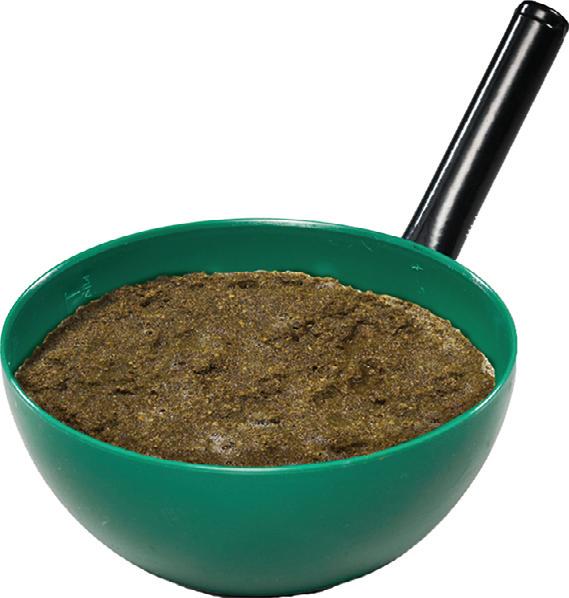

ASuper Fibre conditioning feed, Fibre-Beet is ideal for laminitic horses and ponies needing to maintain condition through the autumn and into winter months.
Fibre-Beet is a formulated blend containing all the benefits of the original Speedi-Beet product, with added high quality Alfalfa for optimum condition and to provide quality protein for muscle tone and function. It provides a good range of minerals, trace elements and amino acids and it is high in fibre with low sugar content, providing slow release energy without the ‘fizz’. Ideal for horses and ponies prone to digestive upsets and very palatable for fussy eaters, Fibre-Beet has added biotin for hoof quality and is suitable for horses and ponies susceptible to laminitis. Soaked and ready to feed in only 45 minutes in cold water, or 15 minutes in warm water, FibreBeet is also ideal for veterans even if teeth are poor or missing. The RRP is £13.50 - £14.50.
www.britishhorsefeeds.com


Pro Gut Balancer is a unique combination of pre and probiotics, together with a mannan oligosaccharide (MOS), to help maintain the health of the gut microbiome in the light of the many challenges faced by modern performance horses to pPromote optimum digestive function and energy production from dietary fibre source. RRP: from £15.40. www.equine-america.co.uk
SEC A ARNIE: ‘I’LL BE BACK’
When owner Suzanne Hibbard saw her 4-year-old, Welsh Section A, Arnie, looking sorry for himself in the field she knew she had to take action.
Arnie is usually fit and well, and Suzanne, a former Horse of the Year Show competitor, shows him in-hand with the talented youngster already catching the Judge’s eye in the competition arena with his stunning looks. This spring Suzanne kept Arnie on his usual routine of being stabled at night and being turned out in the day and she became worried when he suddenly became foot sore one day when she led him to the field. As this was the first time this had happened Suzanne sought advice and it was suggested she look at supplements that could support Arnie. Said Suzanne: “Arnie is such a sweet pony and as an owner you just want to do everything you can to get them back on track. “A friend suggested I try LaminAid and I decided to give it a go. We also used a therapeutic hoof oil, PodoSens at the same time for his sensitive hooves. “I kept Arnie on restricted grazing and he was in the field for smaller periods of time and in the space of a few days he was walking normally and looked so much more comfortable. “With the combination of the change in his routine, together with additions to his diet we can’t wait to get competing again.” Cavalor LaminAid is a unique balanced combination of several essential oils. Each oil is characterised by a specific structure, composition and effect. They work on various different levels in the body to support metabolism. The oils support the sensitive intestinal flora and bring hormonal and metabolic processes back in to balance. Cavalor LaminAid also supports circulation towards the hoof. Cavalor LaminAid is used in combination with Cavalor PodoSens. Cavalor PodoSens is a therapeutic hoof oil. The blend of essential oils helps provide support for sensitive hooves and promotes hoof elasticity.
www.cavalordirect.co.uk
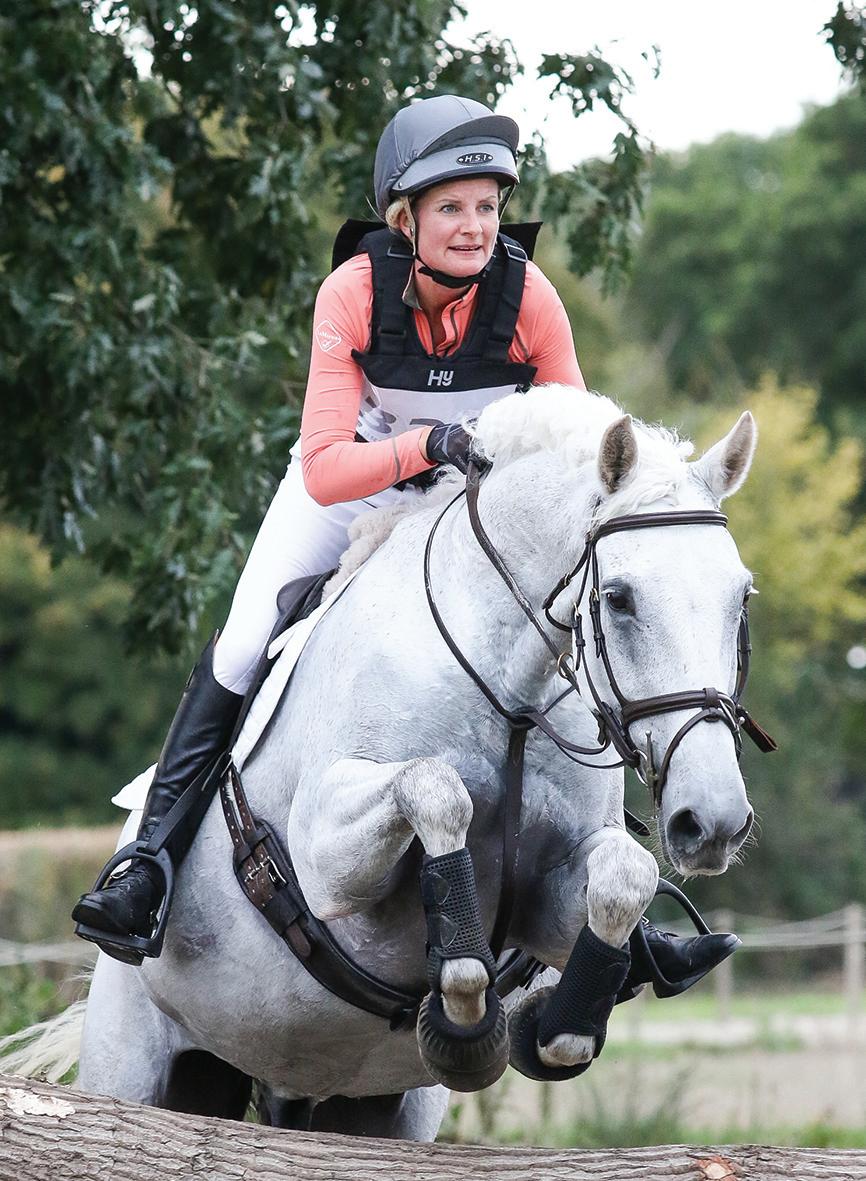
Photo: Jayphotos.co.uk CONFIDENCE BOOST FROM CASPER
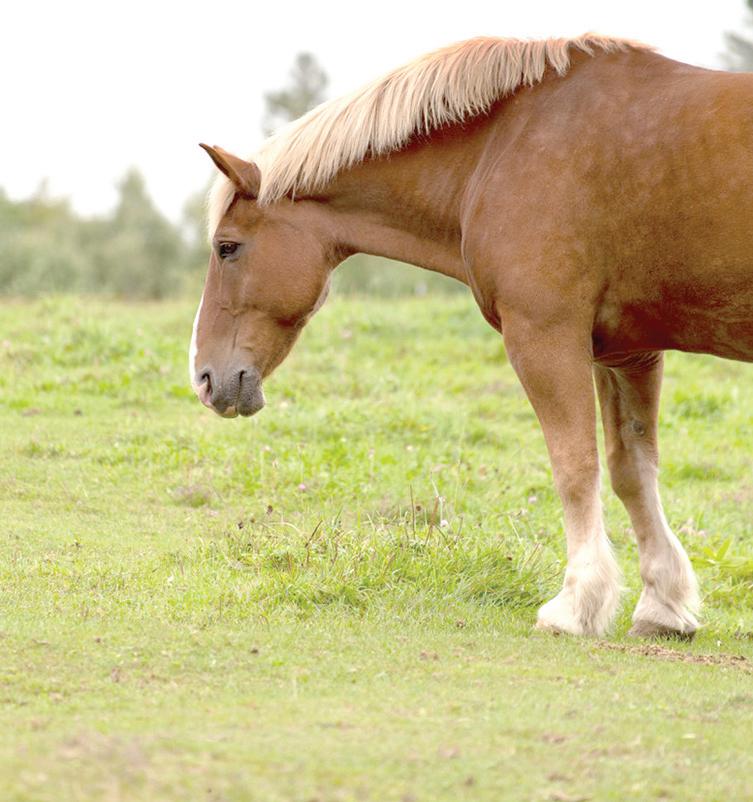
London-based interior designer and part-time potter, Victoria Tar, has recently gained a real confidence boost with her Irish Sports horse, Captain Corlea (or Casper, as he is known at home). She purchased the 14-year-old grey gelding just over six months ago following a six month loan to make sure they clicked and that she was able to undertake the pressures of owning a horse again after a twenty year break.
Casper could be a bit spooky and also got quite stressed when travelling. She started off with lots of lessons and small jumps, increasing things gradually. Casper had formerly been a showjumper and so knew the ropes and, although it was hard work, Victoria’s confidence slowly started to return. Casper is turned out during the night in the summer and is stabled during the day. He enjoys High Fibre HorseHage as his forage all year round and is also fed on Mollichaff Calmer Complete as his spooking became worse when he was on a higher energy feed. This also helped to reduce his stress when travelling. Mollichaff Calmer Complete is a fibre-based complete feed which is low in sugar and starch, providing limited controlled energy from high quality, digestible fibre and oil-based ingredients, making it an excellent feed for horses and ponies that are nervous or easily excited. It also contains a carefully formulated combination of camomile, lemon balm and mint. It can be used as the sole concentrate feed when fed at the recommended levels as it contains a broad spectrum vitamin and mineral supplement.
www.horsehage.co.uk
COVID-19 RESTRICTIONS REVEAL
NEED FOR OBESITY AND LAMINITIS CARE GUIDELINES
The Covid-19 pandemic has highlighted the need for guidelines on the care of horses and ponies at risk of obesity and laminitis, especially during any future lockdown events, a new study has found.
The study Covid-19 impacts equine welfare: Policy implications for laminitis and obesity investigated the implications of Covid-19 related policies on equine management and welfare, with a focus on laminitis and obesity was conducted by Scotland’s Rural College (SRUC), in collaboration with the Waltham Petcare Science Institute who provide the science behind the Spillers brand, during the lockdown restrictions imposed by the pandemic. Key objectives of the study were to assess the impact of the pandemic on the management of laminitis susceptible horses and ponies, to identify challenges faced in implementing Covid-19 based guidance, and to ascertain areas of decision making and policy development which could undergo improvement in future pandemic or emergency scenarios. “We discovered that lockdown-associated factors had the potential to compromise the welfare of horses and ponies at risk of obesity and laminitis,” said Ashely Ward the lead author a PhD student at SRUC. “These included: disparate information and guidance, difficulties enacting public health measures in yard environments, and horses having reduced exercise during the pandemic. “Our conclusion was that guidelines should be developed for the care of horses and ponies at risk through collaborative input from veterinary and welfare experts. This would help to reduce the negative impacts of future lockdown events in the UK.”
www.sruc.ac.uk/all-news/horse-power-helps-ownersthrough-lockdown
FEEDING THE VETERAN HORSE



Like people, not only are horses living longer now, but they are enjoying an active lifestyle for far longer too. As a result, the age old rule of a horse becoming a ‘veteran’ at 16-years is perhaps no longer applicable. Of course, as with people, horses will age at different speeds, and whilst one may start to struggle in its midteens, another may be fit, healthy and remain very active well into their mid or late twenties.
This can leave us as owners with a dilemma as to when we need to start feeding ‘veteran’ or ‘senior’ feeds. Whilst this is an impossible question to give a generic answer to, probably the best advice is to treat your horse as an individual, and so long as he is getting adequate vitamins and minerals, calories and fibre from his current diet, there is no rush to start feeding a specialist ‘veteran’ feed earlier than you need. Dental Issues Teeth are probably one of the most common problems horse owners face with older horses, and whilst good, regular dental care throughout a horse’s life will undoubtedly help delay any serious issues, there is only so much that can be done about wear and tear over a lifetime. Once teeth become badly worn or if some are missing, chewing a long-stem forage may become increasingly difficult for many horses. If you notice bits of partially chewed hay/haylage dropping from your horse’s mouth or scattered round his net, this is a tell-tale sign that he is struggling to cope. It is important to take action at this point to ensure that sufficient fibre is kept flowing through the digestive system, but also to avoid the risk of impaction colic occurring as a result of poorly chewed forage. A solution is to consider feeding a short chop product which is easier to chew but will still supply high levels of fibre without an increase in sugar and starch levels. Consider a product that can be used either as a chaff to add additional fibre to your bucket feed, or as a partial hay replacer for those that are struggling Top Tips for Veterans 4 Think carefully about your forage choices; ensure what you are providing is consistently clean, nutritious and palatable. 4 Try to keep cereal-based feeds to a minimum and when required, provide additional calories through fibre and oil sources. 4 Ensure teeth are checked regularly. 4 Ensure you stick to a good worming routine as worm burden and damage in older horses can cause serious problems. 4 Don’t let your oldie get cold! Your horse burns huge amounts of calories trying to keep himself warm over the winter. 4 Consider feeding digestive enhancers to help him digest his feed as efficiently as possible.


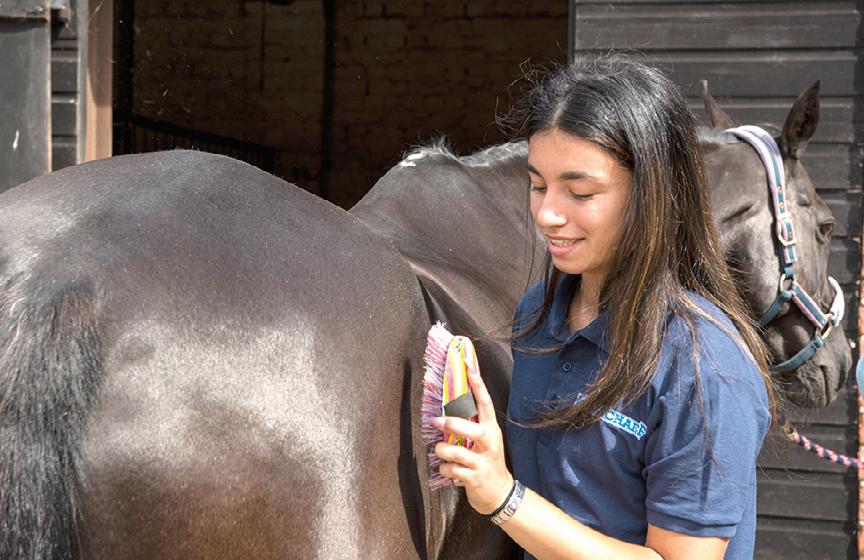
with their hay or haylage. Even for those elderly horses that are still coping with a longstem forage, it is important to remember that it is unlikely they are chewing as efficiently as they once were. This, combined with
the fact that their digestive system probably won’t be absorbing nutrients quite so well, makes it important to feed the best quality and most digestible forage possible. A good quality, bagged forage made from ryegrass can be a good choice for individuals who need a little help with their weight as it will be easy to chew and will provide a consistent level of calories, fibre and nutrients. For those who are still doing well with their weight, choose a lower calorie bagged forage. The added advantage of feeding a bagged forage is that it will be dust-free. Older horses that may have been exposed to dusty forages over the years may be more sensitive to any form of dust in later life and poor quality forage is a known offender when it comes to high dust/mould spore levels. A lot of senior/veteran feeds are higher in calories than the maintenance or low energy feeds which many leisure horses are fed, and as a result of this, starch levels are often increased as well. This can have the potential to cause problems for the elderly horse’s digestive system. As discussed above, elderly horses often have a decreased fibre intake (whether due to loss of appetite, inability to chew, or poor digestive system efficiency); add onto this an increased starch intake, and suddenly the chances of disturbance to the bacteria in the hindgut is much higher. The result of this may result in symptoms such as loose droppings or colic.
www.horsehage.co.uk Winter can be especially challenging for veteran horses and understanding the aging process helps us to provide the best nutritional support. Ageing is accompanied by loss of muscle mass, changes in fat storage and mobilisation, an increase in insulin resistance and, in extreme cases, onset of Cushings.
Additionally, wear and tear systems – joint degradation, onset of laminitis (exacerbated by the preceding disorders) – cause physical damage. Finally, some decrease in enzymatic efficiency occurs and this may affect absorptive capacity, which can act as a stress factor and also impact on biochemical processes. There are two systems in play; metabolic dysfunction has a direct inflammatory input, whilst physical damage indirectly works through inflammatory cues increasing oxidative damage. Feeding the veteran needs to take these parameters into account, and metabolic stresses can be alleviated by improved nutrition, such as more digestible protein, and concentrating on hindgut fermentation for energy production, but supplying bioactives that support the normal inflammation and oxidative processes can be as important. Equally important is to actually improve the bioavailability of these actives, as they can have poor absorbability and systemic life. TurmerAid from The Golden Paste Company addresses these concerns. The major component is turmeric, which contains a range of bioactives

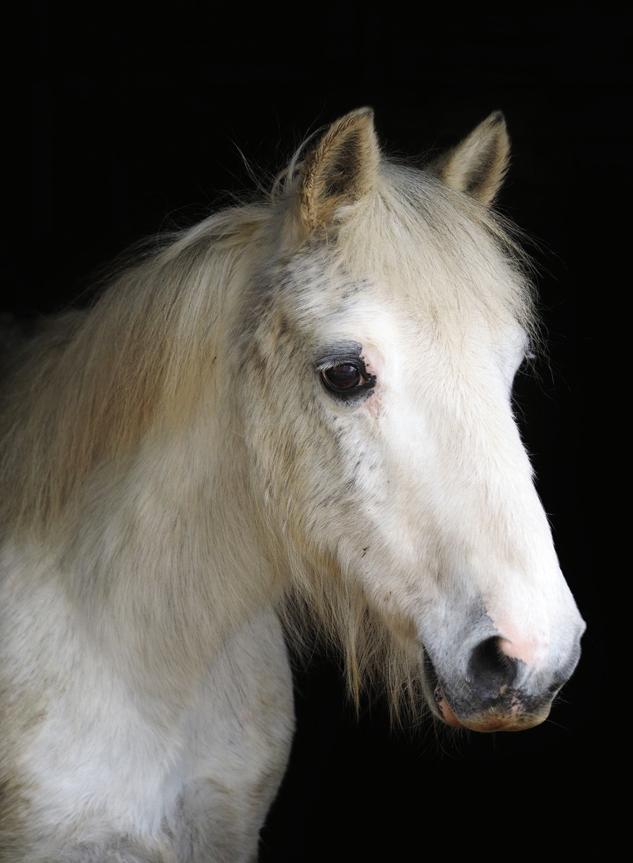
SUPPORTING THE AGING PROCESS
WITH NUTRITION THIS WINTER
from essential oils (terpenes) to polyphenols (curcumin) to sterols; where the terpenes have a direct role in supporting the inflammatory cycle, curcumin is a powerful antioxidant and their interaction is what helps support a myriad of processes involved in ageing. However, it is the additional products in TurmerAid that fully support the veteran. Black pepper and apple cider vinegar both act to increase systemic longevity of turmeric, whilst yucca improves the absorbability of the active ingredients. Both turmeric and beet pectin help improve hindgut fermentation and absorption, which is beneficial to the veteran.
www.goldenpastecompany.com

RRP for a 2kg tub is £19.99. A 15kg sack is also available, RRP £125.99.
LOCATED IN NEWMARKET BUT WORKING BOTH NATIONALLY AND INTERNATIONALLY DONNA CASE BSC (HONS) IS THE HIGHLY EXPERIENCED EQUINE NUTRITIONIST WHO RUNS ‘THE HORSE FEED GURU’, AN EQUINE NUTRITION CONSULTANCY. FORMERLY A COMMERCIAL NUTRITIONIST ACROSS THREE BRANDS, NOW COMPLETELY INDEPENDENT, HER AIM IS TO DEMYSTIFY FEEDING FOR THE GOOD OF THE HORSE AND RIDER.

VETERAN HORSE: ADDED EXTRAS?
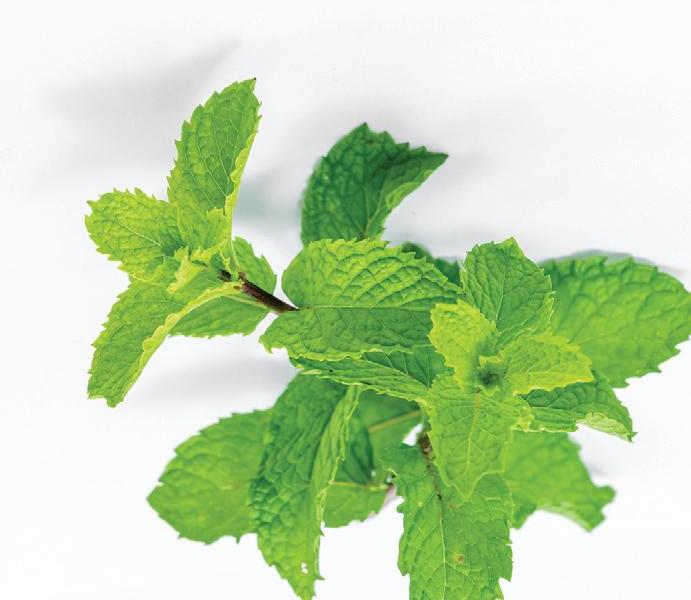
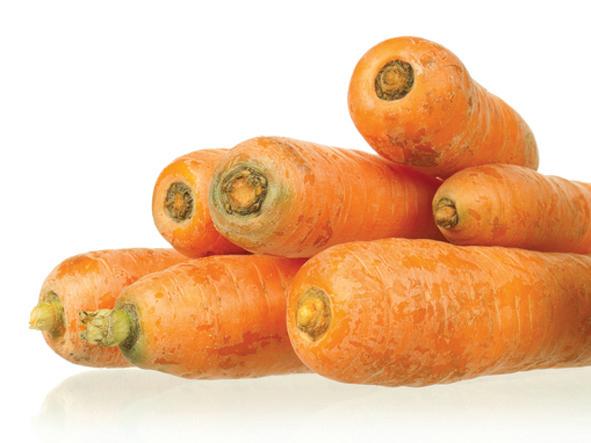
When looking for a veteran feed suitable for your older horse you know you need to find one that will supply the correct energy/calories, quality protein for muscle repair and development, plus a great vitamin and mineral profile to support all round health. But what other ingredients might you come across that may be of benefit?
The first inclusion could be some form of digestive support. As your horse gets older the digestive tract tends to become less efficient. Over the course of his lifetime damage caused by parasites can start to affect him and can hinder the GI tract, leaving scars and reducing digestive function. Some feeds will include pre/probiotic support to support a healthy hindgut microbiome. Look for ingredients such as live yeast, FOS or MOS to aid you with this. Another useful inclusion can come in the form of additional joint support. Quite often when added into a hard feed the ingredients selected are glucosamine and MSM which may be enough to help your horse if he is showing minor signs of stiffness. Be aware however that sometimes a specific joint supplement may be required to provide optimum levels of glucosamine, chondroitin, MSM and Hyaluronic Acid and to make a big enough impact on the joints. Some horses of course require more than just nutritional support and will need medication, so speak to your vet as appropriate. On the topic of medication sadly there is the possibility that your horse may require more in his feed as he continues to age for many different reasons. You may find that this leaves him with a reduced appetite. Many veteran feeds have attempted to combat this through the inclusion of palatable herbs and flavours. A study conducted by Goodwin et al., 2005 found that eight favourite flavours were, fenugreek, banana, rosemary, carrot, cherry (only ever use cherry flavourings as cherries are poisonous to horses), cumin, peppermint and oregano. Some of these spices and tastes are now incorporated into veteran feeds to help with palatability and can be really useful to help to hide some of the taste from the medications you are adding. Finally whilst the feed is likely fully balanced, your older horse may benefit from some additional immune support through an increase in the level of antioxidants such as Vitamin E and C. If increased the manufacturer will often mention this in the description of the feed.
www.thehorsefeed guru.com

Product Suggestions...

Everyday Vitamin and Mineral - providing over twenty-five essential vitamins, minerals and trace elements that may be missing in the diets of horses and ponies. Everyday Vitamins and Minerals is an ideal way to help ensure optimum health and performance. Contains probiotics and prebiotics to support digestive health. Ideal for horses and ponies on forage-based diets or low concentrate feed intakes. Contains both probiotics and prebiotics to support the gut microbiome and immune system. RRP: £25.70/1.5kg. www.equine-america.co.uk
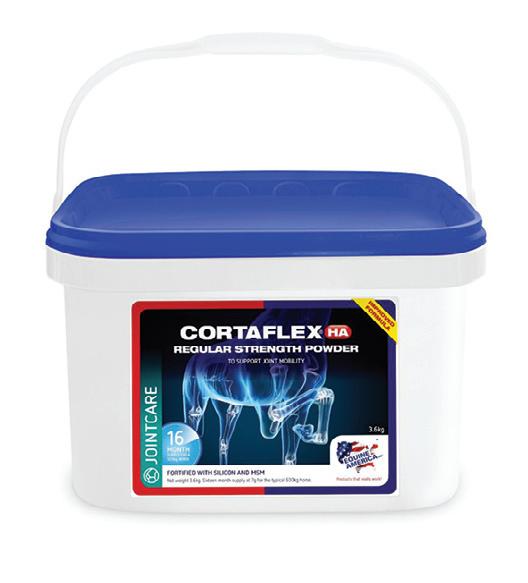
Cortaflex HA Regular powder is designed for the nutritional maintenance of healthy joints in horses and ponies in light to moderate work, or older horses needing a little extra mobility support. Provides key nutritional building blocks for joint support including collagen, amino acids, MSM, hyaluronic acid and trace elements. From as little as 56p/per serving, available in powder and liquid form. www.equine-america.co.uk
Elite Equine 100% Organic Rosehip Supplement
Elite Equine is formulated from 100% organic rosehip powder which is harvested by hand, high in the mountains of Lesotho. Once collected, the rosehip fruit is dried and ground up. No additives or bulking agents are used.
This pure grade of rosehip found in Elite Equine’s Organic Rosehip supplement, has been proven valuable in improving the general health of horses, protecting cartilage, reducing inflammation and promoting the overall performance of horses. Inherently anti-inflammatory and a powerful antioxidant, rosehips can also be fed to horses recuperating from illness or injury as they help to restore the immune system and aid tissue repair. Studies have shown that in many cases rosehip can complement, or even replace, the use of traditional NSAIDs that often lead to stomach ulcers and other secondary ailments. Rosehip is a natural producer of biotin and has been known to address poor coat quality, unhealthy skin conditions, allergies, and brittle hooves. Unexpected benefits include being an appetite stimulant and addressing poor gut health.
www.eliteequineuk.com
RRP: £38/1kg.
Equine Products UK has launched Equine OAP, a nutritional supplement for veteran horses and ponies. Equine OAP is a comprehensive nutritional supplement containing a blend of vitamins, minerals, trace elements, probiotics, prebiotics and a protein source to support the health and vitality of senior equines. The aging process can have an impact on the nutritional requirements of horses and ponies, meaning that, particularly if they are roughed off and live on a forage-based diet, they require additional nutritional support. The Equine OAP supplement has been carefully formulated to support digestion, hoof growth, mobility, bone health, muscle maintenance and energy and vitality. RRP: £39.60/1kg. www.equine products-ukltd.com
THIRST QUENCHING VENDING MACHINE FOR HORSES
It is a well-known fact that many horses do not drink enough when traveling to and from shows and events.
Equidiet (UK) Ltd have set out to tackle this problem by teaming up with Richmond Equestrian Centre to offer ‘HiDrate’, the world’s first equine vending machine. Proprietor Abigail said, “I’m delighted to be the first equestrian centre to install this equine vending machine; we have used these products in the past to help with a colic on the yard and we think this is a fantastic idea for our visiting customers.” Hi-Drate has been designed to instantly quench the thirst and demands of equines. It is the only way to preload water into the digestive system by providing a nutritious drink that forms a soluble fibre gel which travels further into the digestive system to increase the hindgut reservoir. Packed full of natural wholefood goodness, Hi-Drate is based on a mixture of the highest quality British-grown grasses and plantbased Omega 3 oil. Developed in the UK by Equine Nutritional Hydrotherapist Sandra Murphy BSc, the unique patented hydration and nutrition system allows voluntary uptake of large amounts of water attached to excellent quality soluble fibre. Hi-Drate will be available at additional equestrian centres across the UK in due course. To order your vending machine visit the website.
www.equidiet.org.uk

Graze-on Grass Treats even greener...
As demand for more environmentally friendly packaging grows, Northern Crop Driers relaunch their 2kg Graze-On Grass Treats in a new recyclable pouch.
Previously available in a 2kg plastic tub, the new pouch drastically reduces packaging waste and is made from recyclable material. The green credentials don’t stop there, the treats themselves are made from 100% natural dried grass and they are manufactured using renewable electricity. Featuring the eye-catching Graze-On brand livery, the new standup pouches will be available in store from early September. Available to buy individually, in outers of 5 x 2kg pouches or by the pallet - 275 pouches. RRP £4.50 per pouch.
www.northerncropdriers.co.uk

Have you had your Grassabix?
Alnwick based equine company Silvermoor Ltd has expanded its operations with the launch of their latest product Grassabix. The 1kg dried grass forage block is available in three different flavours and was created with the aid of a grant scheme from the North of Tyne Rural Business Growth Service.
Grassabix is a complementary feed for horses and ponies to be fed in conjunction with their current diet. It can either be fed directly from the bag or it can be soaked to create a delicious mash. The grass forage blocks are specifically compressed for easy feeding, storage and handling. They are available in three different flavours; TurmerAid, linseed and magical minty unicorn, each variety supports the health and wellbeing of horses and ponies. www.silvermoor.com



HORSEHAGE & MOLLICHAFF: LAUNCH NEW WEBSITE
Flying the flag for forage for over forty years, the team at HorseHage & Mollichaff has launched a new website.
Packed with features on everything from an insight into HorseHage and Mollichaff products, brand sustainability, equine nutrition and feeding advice, a postcode finder stockist locater, the informative website also includes a regularly updated news section. With a fresh new modern design but still in keeping with the well-known brand image the site is easy to navigate around and provides plenty of detail. Said Mark Westaway, Marketing Manager at Mark Westaway & Son: “We are delighted to have launched a new website that is extremely user friendly and aesthetically pleasing. “Our news section will be regularly updated with everything from product news, testimonials, rider updates, feeding advice and the latest general horse information.” Eye catching imagery brings the website to life and showcases the fantastic products HorseHage and Mollichaff have to offer.
www.horsehage.co.uk
LOCAL RIDER BECOMES AMBASSADOR
Aspiring showjumper Natasha Hamblin, from Grantham, Lincolnshire, has been appointed as a brand ambassador for the equine feed company Spillers.
Natasha is one of eleven ambitious riders who won their place from 650 entries to join the new Spillers Ambassador Programme. With this substantial leg up from Spillers, Natasha, together with her palomino tobiano sports horse Reuben, hopes to take great strides in fulfilling her equestrian dreams this year. Over the next three years Natasha plans to continue to produce Reuben towards eventing at BE novice/intermediate and above and also compete in pure dressage.











